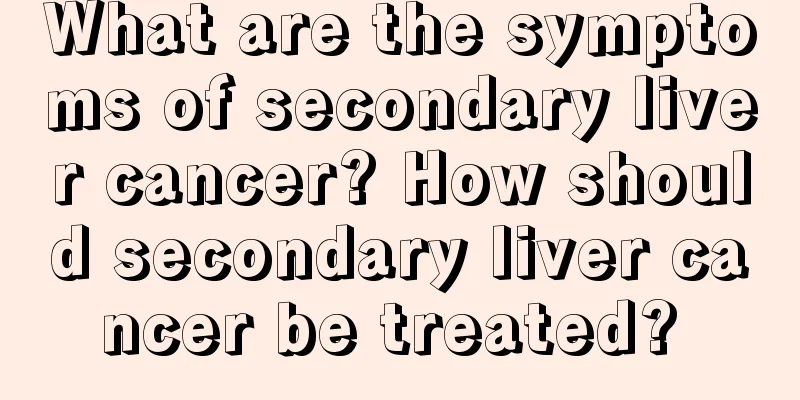What are the symptoms of secondary liver cancer? How should secondary liver cancer be treated?

|
Secondary liver cancer is a condition where primary cancer cells have spread to the liver. Cancers such as bowel cancer, lung cancer, and breast cancer can spread to the liver. For example, when an individual has lung cancer and the cancer cells extend to the liver, then the liver cancer includes cancer cells from the lungs. What are the symptoms of secondary liver cancer? 1. Non-specific symptoms A common symptom of secondary liver cancer is extreme tiredness. Eating small, frequent meals instead of large ones can help control a loss of appetite. Patients may also experience itchy skin. Jaundice may result when the cancer affects a large part of the liver or there is a blockage in the bile duct. Hiccups may occur when the liver presses on a nerve in the chest. Medications may be used to control hiccups. Because the liver helps control body temperature, patients may feel extremely cold or hot. 2. Hepatic ascites In some patients, swelling of the abdomen occurs due to fluid accumulation, and conditions such as blocked lymph glands in the abdomen may prevent the fluid from draining out. Also, when cancer spreads to the liver, it can increase pressure in adjacent blood vessels, forcing fluid out. When the liver cannot produce enough blood proteins, fluid begins to leak from the veins into the abdominal cavity. Doctors insert a needle into the patient's abdomen and drain the abdominal fluid with the help of a catheter, otherwise the fluid may accumulate again. Sometimes doctors permanently insert an inner tube into the patient's abdomen to drain the fluid. How is secondary liver cancer treated? Treatments such as alcohol injections, laser therapy, and microwave ablation are used to destroy cancer cells. In cryotherapy, cancer cells are frozen. 1. Radiation therapy As with X-rays, during radiation therapy, high-energy waves are used to destroy cancer cells. The therapy is used to control symptoms such as pain and cancer cell growth. However, it is not recommended for liver cancer because the liver is very sensitive to this treatment. During selective internal radiation therapy, a catheter is inserted into the hepatic artery, which supplies blood to the liver. Through this tube, the doctor sends a radioactive substance, yttrium, which delivers a dose of radiation to the tumor. In addition to causing damage to the cancer cells, the radiation also interrupts the blood supply to the tumor, a process called radioembolization. 2. Transarterial chemoembolization In another similar procedure, patients are given transarterial chemoembolization (TACE), along with chemotherapy drugs, in an absorbable oily liquid or sponge. The drug mixture prevents the flow of blood, oxygen, and nutrients to the liver while damaging tumor cells. Since the drug mixture is present in the tumor area for quite a long time, the cancer cells receive a high dose of the drug. 3. Radio waves In radiofrequency ablation, radio waves are used to destroy cancer cells, while in radiofrequency-assisted surgery, radio waves are used to destroy cancer cells and remove them from the patient's body. |
<<: How to detect early liver cancer and rule out liver cancer? This test is the most accurate
>>: What is the best way to treat liver cancer? What are the common treatments for liver cancer?
Recommend
What are the types of ovarian cancer
For patients with ovarian cancer, the key to trea...
How long is the recovery period for cerebral infarction
Cerebral infarction is one of a series of cerebro...
What are the symptoms of advanced lung cancer? 3 symptoms of advanced lung cancer
Compared with the early symptoms of lung cancer, ...
What are the effective ways to get rid of bad tooth odor?
Many people have bad breath to some extent. Gener...
Warm up in the gym
We must warm up before doing fitness, because war...
What to do if you have hot flashes, insomnia and dreaminess
Five heart upset heat and insomnia and dreaminess...
What is the reason for often twisting the waist
The waist is a very fragile part. People often ac...
What are the symptoms of a leg embolism?
Calf vein thrombosis is a very common peripheral ...
What symptoms will patients with esophageal cancer experience?
Esophageal cancer is a disease that brings great ...
Growing up with children
The healthy growth of children is what parents ca...
What are the symptoms of lung cancer if the lung nodules are present
Lung nodules may be an early manifestation of lun...
What is the best way to disinfect underwear
In life, many women have very good hygiene habits...
Women's Endometrial Cancer Hospital
Which is the best hospital for the treatment of e...
The best medicine for treating hemorrhoids
With the increase of modern work pressure, many p...
What are the folk remedies for lung cancer treatment? If lung cancer is confirmed, try 4 folk remedies
Chemotherapy is essential for lung cancer patient...









